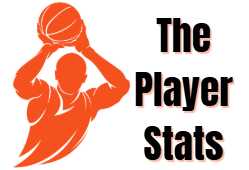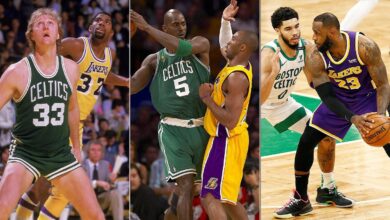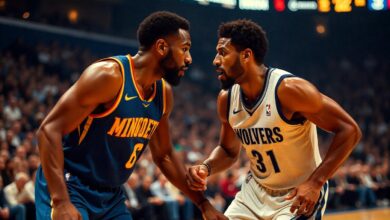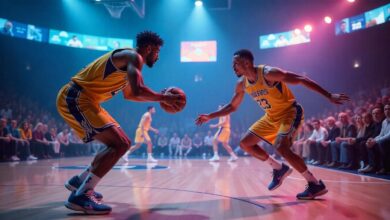Youth vs Experience: How NBA Generational Gaps Play Out on the Court

In the world of professional basketball, the clash between youthful exuberance and seasoned experience creates some of the most compelling narratives on the court. The NBA, with its blend of rising stars and established veterans, serves as a perfect stage to analyze how generational gaps influence performance, particularly in high-pressure games. From a developmental analyst’s perspective, this dynamic is not just about raw talent or physical ability—it’s about maturity, decision-making, and the psychological resilience that comes with experience. The recent Oklahoma City Thunder vs. Dallas Mavericks playoff series offers a fascinating case study of this ongoing battle.
Contents
The Developmental Arc: Youth and Its Growing Pains
Young players in the NBA often enter the league brimming with potential but still in the early stages of developing the mental toughness required for playoff basketball. Take the Oklahoma City Thunder, a young team defined by the emergence of players like Shai Gilgeous-Alexander and rookie Chet Holmgren. Gilgeous-Alexander, despite his youth, has shown flashes of leadership beyond his years. His ability to control tempo, make plays, and maintain composure under pressure reflects a maturity often seen in veterans.
Chet Holmgren’s rookie season, marked by high expectations, also revealed the challenges young players face when transitioning to the intensity of the NBA playoffs. His athleticism and skill are undeniable, but adapting to playoff physicality and speed requires time and experience. Similarly, Jalen Williams has impressed with his on-court intelligence and poise, qualities that bode well for his future development.
From a developmental standpoint, these young players are in the critical phase of building their playoff IQ. They must learn how to read defenses, manage game momentum, and execute under stress—skills that veterans have honed over years of repeated high-stakes exposure.
Experience: The Veteran Edge
On the other side of the court, the Dallas Mavericks present a contrasting picture of seasoned experience. Led by Luka Dončić, a player who has been battle-tested in multiple playoff runs, the Mavericks exemplify how experience manifests in execution. Dončić’s court vision, ability to create shots, and clutch performance are hallmarks of a player who understands the rhythms of playoff basketball.
Kyrie Irving adds another layer of veteran savvy. Known for his calm under pressure and scoring ability in critical moments, Irving brings a level of poise that can stabilize a team’s offense when the stakes are highest. Meanwhile, role players like PJ Washington adapt their games to complement the team’s veteran core, showcasing flexibility and situational awareness cultivated through years in the league.
Veterans like these demonstrate that experience isn’t just about physical skills; it’s a mental framework that governs shot selection, risk management, and leadership during crunch time. Their lower turnover rates, better decision-making in clutch moments, and ability to anticipate opponents’ strategies are critical advantages.
Statistical Markers of the Youth vs Experience Divide
One way to quantify the gap between youth and experience is by analyzing possession efficiency, turnover rates, and clutch-time performance. Younger players typically have higher turnover rates, a reflection of less refined decision-making. In the Thunder-Mavericks series, this trend is visible in how OKC’s younger core struggled with controlling the ball under intense defensive pressure from Dallas.
Possession efficiency also highlights how veterans optimize scoring opportunities. Luka Dončić’s ability to maintain a high true shooting percentage during clutch moments contrasts with the Thunder’s more inconsistent offensive production. This efficiency difference underscores how experience translates into better shot selection and composure when the game is on the line.
Clutch-time decision-making, measured by points scored, assists, and turnovers in the final minutes of close games, further illustrates this gap. Veterans tend to reduce errors and increase productive plays, while younger players might still be learning how to handle the pressure without forcing mistakes.
Psychological Resilience and Tactical Adaptation
Beyond numbers, the psychological dimension of experience is critical. Playoff basketball is a crucible that tests mental toughness—how players respond to adversity, crowd pressure, and the physical toll of repeated high-intensity games. Veterans often display a calm resilience that steadies their teams, while younger players may initially succumb to nerves or overexertion.
Coaches play a vital role in nurturing this resilience. By designing game plans that incrementally expose young players to high-pressure scenarios and encouraging reflective learning from mistakes, teams accelerate their developmental trajectories. The Thunder’s coaching staff, for example, has focused on building confidence and decision-making skills in their young core, recognizing that growth under fire is essential for future success.
Tactically, experience also means better adaptation. Veterans read the game and opponents’ strategies more quickly, allowing them to adjust on the fly. Young players are still developing these instincts, which sometimes leads to slower reactions or hesitation. Over the course of the series, the Mavericks’ ability to exploit mismatches and adjust defensive schemes revealed the practical payoff of experience.
What Front Offices Can Learn
For NBA front offices, the Thunder vs. Mavericks matchup offers valuable insights into roster construction and player development. Investing in youth provides long-term upside but requires patience and a supportive environment to foster growth. Complementing young talent with experienced mentors can accelerate learning and help translate potential into playoff success.
Balancing minutes, managing workloads, and providing targeted skill development are crucial strategies. Moreover, psychological coaching and resilience training should be integral parts of player development programs. Experience isn’t only gained through games; it’s cultivated through deliberate practice and mental conditioning.
Conclusion: The Ongoing Battle of Generations
The generational gap in the NBA is not simply a matter of age—it’s a nuanced interplay of physical ability, mental maturity, and basketball IQ. High-intensity playoff games serve as proving grounds where these differences are most evident and impactful.
The Oklahoma City Thunder’s youthful core is rapidly gaining valuable experience by competing against the seasoned Mavericks, illustrating how exposure to playoff pressure accelerates growth. Veterans like Luka Dončić and Kyrie Irving exemplify the strategic and psychological advantages honed through years of competition.
Ultimately, this youth versus experience narrative is less about which side dominates and more about how these contrasting forces coexist and propel the evolution of players and teams. For coaches, trainers, and front offices, understanding this dynamic is key to unlocking sustained success in the NBA’s ever-competitive landscape.





